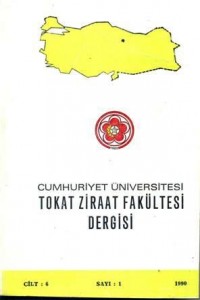Abstract
Vinegar is a tasty aiment which is produced by the resuist of acetic acid fermantation of the intoxicating maishe of fruits, especially grape. Vinegar, which is am important product of food industry, has a wide area of using. There are apporoximaiely 15 installations pro- ducing vinegar in our country. And about 10 small installations occa- tionoily produce vinegar to the market, it's guessed that probably some of the vinegar installations add1 synthetic acetic acid in the vinegar. Therefore, it has gained a major importance, to determine the component of natural fermantation vinegars and also separate the syntetic acetic acid added into them. For this reason investigations are done; trying to reach to the agreeable crieria, by developing easy application met¬hods. With the standard laboratory analysis it doesn't seem possible to determine, the criteri that shali bring certain results in this area. On the other hand, it seems possible to differentiate natural fermantation vinegar from the vinegar that has contributed with synthetic acetic acid only by studing the life of carbon atoms. There aren’t any radioac¬tive carbon; measuring iabrotories yet in our conutry to serve the aim, so it's necessary to find classic analysis procedures to differentiate the natural vinegar and contributed vinegar from one another. In this rese-arch, asetil-metil-karbinol (AMK} test which is being used heretofore at the separation; of natural vinegar from the synthetic acetic acid cont¬ributed vinegar, is studied also with the other analysis methods for to emphasize the data. It has been clear hat, by determining the sugariess sharp matter-, unevaporate acid, oxidation number, number of ester; number of iodine and other things, together with AMK test gives a heal¬thier and reiaible result; But at first mtural vinegars must be produced in order to find out he average amounts of the above menioned things.
Keywords
Tabii Ve Katkılı Sirkelerin Ayırımında Esas Alınacak Kriterlerin Belirlenmesi Üzerinde Bir Araştırma
Abstract
Sirke başta üzüm olmak üzere meyvelerin alkollü mayşelerinden Asetik asit Fermantasyonu sonucu elde olunan çeşnili bir gıda maddesidir. Gıda Sanayiinin önemli bir ürünü olan sirkenin çok gen.ş kullanım aleni bulunmaktadır. Ülkemizde sirke üreten 15 kadar iş¬letme vardır. Ayrıca 10 kadar daha sirke üreten küçük kuruluş zaman zaman piyasaya sirke sunmaktadır. Sirke işletmelerinin bir bölümünün sirke içine sentetik asetik asit kattıkları sanılmaktadır Bu nedenle tabii fermantasyon sirkelerinin bileşimlerinin tesbiti ile bunlara katılan sentetik asetik asitin ayırt edilebilmesi büyük önem kazanmaktadır. Bu amaçla yapılan araştırmalar ile kolay uygulanabilir yöntemler geliştirilebilecek uygun kriterler getirilmeğe çalışılmıştır, Bu alanda bizi kesin sonuçlara ulaştıracak kriterleri saptamak standart labaratuvar analizleri ile mümkün görülmemektedir. Ancak karbon atomların ömür¬lerinin tespiti suretiyle tabi; fermantasyon sirkesi ile sentetik asetik asit katkılı sirkeleri birbirlerinden ayırmak mümkün görülmektedir.: Bu amaca yönelik olarak ülkemizde radyoaktif karbonları ölçebilecek labaratu- varların henüz bulunmayışı, kalalı sirkelerle tabii sirkeleri birbirlerinden ayırt etmeye yarayacak klasik analiz yöntemlerinin bulunması zorunlu¬sunu ortaya çıkartmaktadır. Bu araştırmada tabii sirkenin sentetik ase¬tik asit katkılı sirkeden ayırt edilmesinde öteden beri kullanılan Asetil- Metil-Karbinol (AMK) testi İle birlikte, bulguyu pekiştirecek başka analiz yöntemleri üzerinde de çalışılmıştır. Şekersiz katı madde, Uçmayan asit, kül, Oksidasyon soy sı; ester sayısı ve İyot sayısı. gibi tayinlerle birlikte AMK testinin daha sağlıklı ve daha güvenilir bir sonuç vereceği anlaşılmaktadır. Ancak önce bu amaçla tabii sirkeler üretilip anılan maddelerin ortalama miktarları ortaya çıkarılmalıdır.
Keywords
Details
| Primary Language | Turkish |
|---|---|
| Journal Section | Research Articles |
| Authors | |
| Publication Date | June 1, 1990 |
| Published in Issue | Year 1990 Volume: 1990 Issue: 1 |


